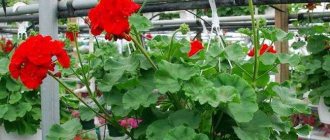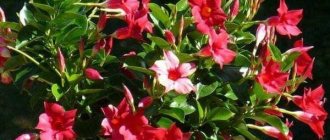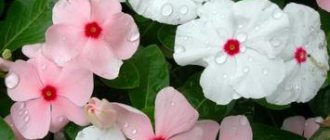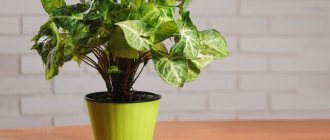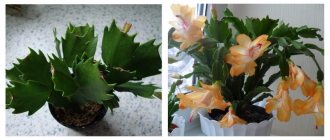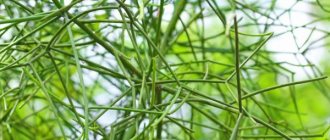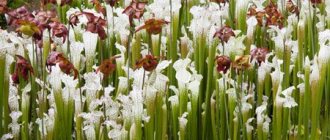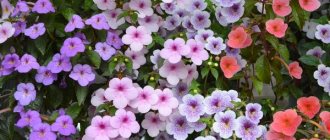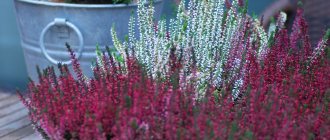The popularity of geraniums in the last century can be judged by the interiors, photographed and captured by cinema, and from the recollections of the elders of the family. In houses it was customary to hang white curtains on the windows, and place pots of geraniums on the windowsills. It has been noted that the flower has a beneficial effect on the atmosphere in the family. And geraniums with inflorescences of different colors are attributed to different influences (always good) on a person’s fate.
Pelargonium
Essential oils secreted by the green part of the plant have a specific odor. Some people like it, some don't. Thanks to the essential oils distributed, the flower has bactericidal properties, and geranium is often placed in the room of a sick person for a speedy recovery.
This beautiful, unpretentious flower is still popular today. Grandfathers and grandmothers still have a pot of geraniums on the windowsill. A flower with bright inflorescences decorates balconies, delights with the beauty of colors in personal plots, in the country, within the city.
How to grow pelargonium correctly?
About the plant
Ampelous (or climbing) geranium is the same pelargonium, but unlike artisanal species, the branches of such a plant reach a length of up to 90 cm. If you plant such a flower in a hanging pot, its branches will gracefully hang down, decorating the room with their presence. The leaves of the flower resemble a star in shape, have a dense structure and can be plain or variegated.
The inflorescences can be either pink or spherical, double. Ampelous geranium can be a perennial indoor plant or an annual flower intended for growing in the garden. In addition to their elegant appearance, such plants are also distinguished by their unpretentious nature, so even a novice gardener can cope with their maintenance.
In order for ivy-leaved ampelous pelargonium to please you with a healthy appearance and full flowering, it requires competent care. On how to properly care for geraniums in order to get the desired result, you should follow the following rules.
Features of caring for and growing ampelous geraniums at home
Pelargoniums or indoor geraniums are loved all over the world for their flexible, non-capricious disposition and bright flowering.
But along with the common bush forms, ampelous geranium - or thyroid pelargonium or ivy-leaved pelargonium - is increasingly being used for vertical gardening, decorating flowerpots and hanging flowerpots. The species Pelargonium peltatum stands out not only for its ability to form elegant, but quite strong flowing shoots up to a meter long. A characteristic feature of this variety of indoor geranium is its dense five-fingered leaves of even green or variegated color. See also the photo of the oleander flower!
In the axils of the leaves, at the tops of the stems, tall peduncles are formed, bearing lush umbrella inflorescences. Flowers can have different shapes, from simple star-shaped to double or pink, and a wide variety of colors. Flower growers have varieties with single-color and two-color corollas with a diameter of 1.5 to 4 cm at their disposal.
Lighting
Caring for climbing geraniums at home involves providing the plant with sufficient light. If there is a deficiency of light flux, the flower will only stretch upward, but will not please its owners with a single bud. The ideal option for placing a pot of pelargonium would be a bright window sill of an eastern or western window, where there is diffused light.
If you place a container with geraniums on a northern windowsill, the plant will not receive the proper amount of light to form buds. At the same time, a southern window sill with constant presence of direct sunlight is also not a suitable option. Direct exposure to sunlight can cause burns on the delicate skin of the leaves.
Important! If you nevertheless decide to place the flower on a southern windowsill, additional shading will be required. Otherwise, the pelargonium leaves will become covered with spots.
Caring for ampelous pelargonium
How to care for ampelous pelargonium
Pelargonium is light-loving, and (which is a rare advantage) tolerates direct sunlight well. It stoically tolerates dry soil and air, but dies when overmoistened, so it needs good drainage. Pelargonium is not afraid of severe cold, but it dies from light frost. Pelargonium does not need to spray the leaves; moreover, it is contraindicated for it, because rot will appear on the leaves, and this will lead to serious diseases.
Fertilizer of ampelous pelargonium
Ivy pelargonium should be fed weekly during the flowering period (from March to August) with low-concentration complex mineral fertilizer. She also likes to drink milk diluted with water. The soil for geraniums needs loamy, light, fertile, high potassium content, but low nitrogen content: with its excess, the leaves of indoor geraniums become larger, but flowering slows down. The soil mixture should be approximately this: two parts each of turf soil, lowland peat and leaf soil and one part sand.
Transplanting ampelous pelargonium
Ampelous geraniums need to be replanted once every two years in the spring into a tight pot (the roots should be located close to the walls). If the old pot is still old enough for the plant, replace only the top layer of soil.
Reproduction of ampelous pelargonium
Pelargonium can be grown from seeds, but there are too many nuances to consider. Only experienced gardeners can do this, but they also prefer to propagate pelargonium by cuttings. Cuttings that have been pre-dried for 24 hours (the cuts must be dry) are dipped in charcoal powder and planted in disinfected (with boiling water or in the oven) soil at a distance of 2 cm from each other, compacting the soil on all sides with your fingers. It takes a month for the cuttings to take root, and if the planting took place in the spring, then in the summer your cutting may bloom.
Caring for ampelous pelargonium in winter
During the dormant period, in winter, if you can place pelargonium under additional lighting, you don’t have to cut off the ground part. If this is not possible, then cut off all the branches and store it at an air temperature of +7°C in a bright place. When wintering pelargonium at room temperature, keep the pots as far as possible from heat sources and be prepared for the fact that it will bloom much later, especially its double varieties. During the dormant period, it should be watered rarely, once every 1.5-2 weeks.
Nowadays, garden centers sell a huge variety of homemade geraniums, including ampelous pelargoniums, with decorative leaves and flowers of magnificent colors. Just a few of these seedlings will create a magnificent long-flowering cascade on your balcony, which will provide you and your neighbors with a great mood for the entire summer season.
We also suggest that you get acquainted with the queen among geraniums - royal pelargonium.
Temperature
Ampelous geranium is a heat-loving flower, so the optimal temperature indicator for such a plant is no lower than +18 °C.
It is worth mentioning that pelargonium is not afraid of a decrease in temperature and will not die if the thermometer drops below the specified mark. But flowering and growth of succulent leaves may stop. At sub-zero temperatures, the plant may die. In addition to low temperatures, which may not have the best effect on the condition of pelargonium, the flower is also afraid of drafts. Therefore, when placing pots with geraniums in an open space, make sure that strong winds do not damage the stems of the hanging plant.
Ampelous species of pelargonium (geranium)
Hanging plants are plants for hanging gardens. They have flexible shoots that can both curl along walls and hang down spectacularly. The ampelous species of geraniums include ivy-leaved or thyroid pelargonium (Pelargonium peltatum). It comes from South Africa, where in nature it cascades down the hillsides. The shoots of ampelous pelargonium reach a length of 90 cm. It also differs from its zonal (vertically growing) relative in that its leaves are not covered with fluff, but have a smooth surface. They are five-lobed, fleshy, green or white-variegated, from 3cm to 6cm wide.
Pelargonium ivy-leaved flowers have star-shaped and cactus-shaped shapes. They are located on long peduncles and collected in umbrella inflorescences up to 8 cm in diameter. The inflorescence contains up to 30 flowers, each of which blooms for 5-6 days. Flowers come in simple and double colors, in all possible shades: white, pink, purple, lilac, two-color, with a border, strokes, spots...
Related article: Spider mites: how to fight on indoor plants, in a greenhouse and on seedlings
Watering and humidity
Watering is one of the most difficult points in caring for the hanging type of pelargonium. Watering geraniums at home should be done carefully, taking into account the condition of the flower. It’s worth saying right away that this plant variety does not tolerate waterlogging. Therefore, in order not to harm your pets, be sure to follow the following rules:
- It is necessary to water pelargonium in the morning to avoid stagnation of water at the roots.
- If water gets on the leaves or buds, they may begin to rot. Therefore, you should water the flower, carefully protecting the components of the plant from the harmful effects of water.
- You should not spray ampelous geranium even on the hottest days of summer. In this way, the development of putrefactive processes can be caused.
The flower is provided with abundant watering only during growth, the formation of new buds and flowering. In winter, the intensity of irrigation is reduced to a minimum.
Home care rules
Ampelous geranium is a light-loving plant that tolerates direct sunlight well. Resistant to dry air and soil, but may die if exposed to excess humidity. How to care for pelargonium so as not to harm it.
Important! Hardened specimens of pelargonium tolerate a significant drop in air temperature. If the column drops below zero, freezing of the top cannot be avoided.
In order for the flower to feel good, it is necessary to follow a number of rules:
- Lighting. Geraniums must be placed in a well-lit place. Can be placed on a windowsill on the west or south side. If placed on a north or east window, the flower will not have enough light and warmth. This will slow down the development of the flower and negatively affect the condition of the inflorescence.
- Temperature. Although pelargonium loves warmth and was brought to Europe from Africa, it has a hard time withstanding the heat. Optimal temperature is +20-25 degrees.
- Watering. The plant should be watered regularly. Make sure that there is no stagnation of water in the pan. To prevent excessive moisture, the bottom of the flowerpot is covered with a drainage layer.
Important! Spraying leaves of ampelous geranium is contraindicated; rot may develop on them.
Summer flower care
Home care during the summer period includes from March to the end of August. The flower wakes up after winter, it needs to be provided with decent care and feeding.
Advice! For fertilizer, you can use diluted milk with water.
In order for the geranium to bloom profusely throughout the entire season. In the spring, she needs to add fertilizer, which contains a significant amount of nitrogen. But the second and third feeding should be limited to this chemical element. Otherwise, in the place of a beautiful inflorescence, you will only be able to admire the large leaves.
Important! When the roots of the plant completely occupy the entire space of the pot, it is worth replanting. Geranium, regardless of age, tolerates this procedure well.
Ampere pelargonium is unpretentious to the soil in which it grows. You can take the soil either from your summer cottage or buy a ready-made substrate in the store. You can form the soil yourself by following the instructions step by step:
- Prepare eight parts of soil with turf.
- One part sand.
- Two parts of humus.
In order for the flower to bloom beautifully and abundantly, the shoulder straps are trimmed. When cutting, leave a stem with 4-5 leaves. Mostly shoots above the leaves are removed. The cuttings can be used in the future as planting material.
Replanting and pruning are carried out mainly on warm days.
The plant does not tolerate temperatures above 25 degrees; it should be placed in the shade. If this is not done, the flower will get burned, the leaves will become covered with red spots and dry out.
If geranium grows in open ground, it may be infected with insect pests. The flower should be inspected regularly. If parasites are detected, treat the infected plant with a special solution.
Winter care
In winter, pelargonium goes into a dormant state. You should first prepare the plants for wintering. In the fall, when the last inflorescences have faded, the next pruning is carried out two weeks later. Cut off all dried branches, leaves and flowers, trim the stems in the area of the casting axils.
Important! Before the procedure, instruments must be disinfected, and the cut area must be sprinkled with charcoal.
For winter dormancy, amperous pelargonium requires:
- the plant is placed in a cool place, the optimal temperature is 5 -12 degrees Celsius;
- provide bright and diffuse lighting;
- reduce the amount of liquid entering the soil, once every two weeks.
Important! Insufficient light in winter will lead to the formation of weak stems with small leaves on the bush.
If it is not possible to place the flower under additional lighting, all branches should be cut off. They should be stored at a temperature of seven degrees Celsius in a bright room. With the onset of spring, plant them in prepared soil.
Soil selection and fertilizing
The soil should be loose, nutritious, light and at the same time rich in potassium. You can purchase the substrate in a specialized store or prepare it yourself. To do this, it is worth mixing leaf and turf soil, as well as peat, humus and sand, in equal proportions. Since climbing pelargonium is a mountain plant, drainage in the pot will be required. For this purpose, you can use crushed expanded clay.
In order for geraniums to bloom well and produce new leaves, it is important to choose a pot of a suitable shape. For adult individuals, containers with a diameter of about 10–12 cm are ideal. As for the material, the best option would be a pot made of porous ceramics. This material allows a sufficient amount of air to pass through, so the roots will be protected from stagnant moisture and rotting.
Important! Nitrogen-rich soil will not work. In this case, the flower will actively grow leaves, but without flowers.
In order for healthy flower development to occur, it is necessary to use complex fertilizers. For this purpose, concentrated mineral fertilizers can be used. It is also allowed to use fertilizers for flowering indoor plants or preparations intended for geraniums. It is not recommended to feed climbing geraniums by foliar feeding.
Important! Feeding should be done moderately. It is recommended to do this mainly after pruning has been carried out, as well as during the flowering period.
How to propagate a plant at home?
The most acceptable way to propagate ampelous geraniums at home is the vegetative method, namely with the help of cuttings: this method is simple (even beginners in floriculture can do it), fast (the first flowers will bloom soon), and when cuttings, all the characteristics of the mother plant are preserved ( color, leaf color, flower shape and size, etc.).
Cuttings
Propagation of ampelous geraniums by cuttings is best done in spring and summer during seasonal pruning. Autumn and winter shoots will produce weak and disease-prone plants.
Spring and summer are a period of active plant growth: it is during these seasons that all metabolic processes occurring in the plant, including the processes of building new cells, accelerate. In addition, it is in spring and summer that it is easy to create all the conditions that contribute to the painless rooting of petioles: a lot of sunlight, an optimal temperature level.
From the video you will learn how to root cuttings of ivy-leaved pelargonium:
Preparation of planting material
- A healthy, strong, non-flowering shoot without visible damage is selected.
- The apical part of the shoot, at least 10 cm long, is cut from the ampelous geranium bush below the node with sharp scissors or a knife.
- Treat the cut with crushed activated carbon, which will help avoid putrefactive processes; you can also treat it with the drug “Kornevin”.
- Remove all lower leaves from the shoot. There should be at least 2-3 buds left on it.
- It is recommended to dry the petiole for 24 hours.
Rooting
Rooting is the process of the appearance of the root system of a shoot cut from the mother plant. Ampelous geraniums should be rooted in the ground. It should be loose, airy, air- and water-permeable. An integral element of the substrate should be sand. One option: mix turf soil, sand, and peat in equal proportions. It is recommended to first disinfect it with fungicides or thermally.
The cut and dried petiole is dipped with the tip into a root formation stimulator, for example, “Kornevin”. Next, the shoot is buried 3–4 cm into the moist soil; the ground around it should be well compacted for better fixation of the seedling. Several cuttings should be rooted into pots at a distance of 2–3 cm from each other so that young plants do not intertwine their roots with each other. After 2 - 3 weeks, the shoots will produce roots, then they can be planted in individual pots.
The optimal conditions for the development of shoots are considered to be a temperature of +20C – +25C , moderate watering (as the top layer of soil dries out), and diffused sunlight.
Planting in the soil
After the cuttings have formed a root system, they need to be transplanted into individual pots.
To do this, you need to prepare a container in advance, fill its lower layer with expanded clay or brick chips, and then with a substrate from the store or a mixture of peat and sand. Having made a depression in the soil with your hand, place the seedling in the pot. The best planting method for young seedlings rooting in the ground is the transfer method: the plant is taken out of the container and, without shaking off the earthen lump, is placed in a new pot. The top layer of soil near the stem is pressed down with your hands, the plant is watered and put in its place. It is recommended to plant 5–6 petioles on a pot with a diameter of 12 cm so that the ampelous geranium bush is lush and beautiful.
Seeds
The method of propagating ampelous geraniums by seeds is not as popular as cuttings. But it is necessary when it comes to obtaining new plant varieties, although it requires a lot of labor and time.
In this way, geranium can be propagated from December until the end of April:
- First, the container must be filled with soil (1 part garden soil: 1 part sand: 1 part peat, a little sphagnum moss).
- Seeds pre-soaked for a day in water are sown on its moistened surface and sprinkled with soil to a depth of 3–5 mm. The soil should not be compacted for better seed germination.
- Next, the box is covered with glass or plastic film, not forgetting about daily ventilation of the crops.
- After the seedlings appear and become stronger (after 7–15 days), the coating can be removed. The optimal temperature for growing seedlings is +22C – +24C.
- It is also important to ensure systematic but moderate watering of the seedlings (avoid accumulation of moisture and do not allow the top layer of soil to dry out). To avoid soil erosion, you can irrigate the substrate with a spray bottle.
- After 3 weeks, it is necessary to pick, seating them 2 - 3 cm from each other.
- After diving, in order to stimulate the growth of seedlings, you can begin to feed them with complex fertilizers for ornamental crops.
- And after several true leaves appear, young seedlings should be planted in individual pots.
Reproduction of ampelous geranium
Propagation of ampelous geranium can be carried out in two ways: seeds and cuttings.
According to experts, if you want to grow a flower that is resistant to drafts, infections and temperature changes, you should resort to propagation by seeds, which must be purchased at a specialized store and planted in the second half of winter. The seeds are placed in the substrate to a depth of 1 cm, sprinkled with a thin layer of soil, moistened with a spray bottle and covered with film. The container with seeds should be kept indoors at a temperature of 20–24 °C. Within 2–3 weeks, the soil is moistened and ventilated regularly. When the seedlings produce 2 leaves, they are transplanted into separate pots. It is not easy to propagate ampelous geraniums in this way, so at home it is better to resort to cuttings from adult specimens.
To propagate pelargonium by cuttings, prepare a disinfected substrate consisting of leaf soil, peat and sand. Cuttings are taken from an adult plant. Healthy cuttings are cut, the length of which is 10 cm, on which there are 2-3 leaf nodes. Afterwards, excess leaves are removed from the cuttings, dried for 24 hours and planted in a container with soil. The cut area is treated with crushed coal. After the shoots send out their first roots, they are transplanted into permanent soil and cared for as adults.
Reproduction
A new plant can be obtained from seeds or cuttings. Propagation by cuttings is often used; the most suitable time for it is in late summer and early autumn. To do this, you need to cut a small shoot, 10 cm long, and keep it in the open air for up to 24 hours so that the cut site becomes dry. Before planting, dip the cut area well in charcoal powder, stick the cutting into the prepared light peat soil, and press the soil around the plant firmly. Care - warmth, light, sufficient humidity will help the plant to take root in 4-6 weeks.
Pelargonium cuttings
Propagation by cuttings will be more effective if the mixture prepared for planting is disinfected. This can be done by pouring boiling water over the soil or heating it in the oven for 15-20 minutes.
Collecting pelargonium seeds
Seed propagation is used when you need to get a lot of plants, as in nurseries. Sow seeds in spring in sandy soil. During this period, temperature (19-20 ° C) is especially important for good germination.
When to trim
Pruning is done regularly, which allows you to form a healthy, uniform bush. During the flowering period, it is necessary to cut off the fading inflorescences so that they do not “steal” the nutrients from the flower, and in the fall, when flowering is completed, trim the bare stems and drying leaves. Pruning during these periods will extend the flowering period, improve air exchange, speed up the metabolic process, and also make it easier for the flower to overwinter.
However, autumn and summer days are not the only time when the procedure should be carried out. Pruning is also necessary for pelargonium in the spring. This is necessary to form a beautiful crown and prevent pelargonium from growing upward. It is important to prevent the growth of diseased stems that have managed to grow upward over the winter. Their appearance will not add beauty to the bush. Such branches are cut to 2 leaf nodes. If there are more than 6 leaves on the shoot, you need to pinch the top. Taking such measures will awaken the “sleeping” buds, as well as activate the development of a large number of new inflorescences.
Important! For pruning, use a sharp knife or scissors that have been disinfected. The cut area is sprinkled with crushed coal.
Growing conditions
For good growth and rich flowering, it is necessary to create the right conditions and provide appropriate care. Ivy-leaved pelargonium at home requires nutritious soil, sufficient lighting, and a certain temperature regime.
Lighting and temperature conditions
As for the temperature regime, pelargonium loves a warm climate, so in summer a temperature of +25-28 degrees is suitable for it. Geranium will survive higher rates, but additional moisture will be required. In winter, it is necessary to maintain a temperature of +15, for her this is the optimal indicator at which she can even set buds.
Watering and air humidity
At home, when caring for ivy-shaped pelargonium, the main thing is not to overdo it in watering. Excess moisture is simply destructive for this flower, so it is better not to water it too much than to overwater it. In hot weather, it needs frequent watering, but this should be done in small doses. And it’s better to check the soil first: if at a depth of 2-3 centimeters it is still wet, then you should wait until watering. And in winter, geraniums are watered no more than once a week.
Replanting and fertilizing
If the flowerpot was initially large, then you should not change it, but carry out a partial replanting; for this you just need to update the top layer of soil, with the obligatory addition of the necessary fertilizers. When removing a flower from an old flowerpot, you need to carefully grab the flower by the base and, holding the roots, transfer it to a new container
All this must be done with extreme caution so that the stems and roots of pelargonium are not damaged. Only in this case the flower will quickly adapt and take root in the new soil and pot.
As for the soil, it should be very loose and nutritious. If the substrate is made independently, then it must include:
- river sand;
- garden humus;
- leaf turf;
- peat.
Fertilizing is applied between May and August. The fact is that at this time the flowering period of pelargonium begins, so it needs to be thoroughly fertilized, this is done weekly. Purchased products intended for flowering garden crops are best suited for this. The rest of the time, fertilizing is done much less frequently; it is enough to feed the flower once a month or every month and a half. In spring and autumn, potassium or phosphorus compounds are suitable for them, and in winter it is better to add organic fertilizers.
By the way, many flower growers use ordinary fresh milk as a fertilizer, which is diluted with water in a ratio of 1:2; this fertilizing strengthens the leaves of pelargonium and saturates the flower with the necessary substances.
Pruning and shaping the bush
All pruning is done exclusively with a knife or scissors; tearing or breaking stems is strictly prohibited, since torn stems can rot and thereby harm the hanging plant. Tools used for pruning must be disinfected in advance. And after trimming, you need to treat the cut areas - crushed charcoal or regular activated charcoal in tablets is suitable for this.
All these measures will not only make the flower attractive, but will also rid it of weak and diseased shoots that prevent the flower from developing fully.
How to care to achieve lush flowering?
In order for the plant to feel comfortable at home, it is necessary to provide it with proper and regular care.
We talked in detail about the rules of care and cultivation of ampelous or ivy-leaved geranium here, and from this article you will learn how to propagate a flower.
How to water and what to feed?
Geranium loves moisture very much, so the soil in a pot with a flower should always be moistened , but not excessively, otherwise this will lead to the appearance of mold. To speed up the process of water passage in the soil, appropriate drainage must be selected. In winter, the frequency of watering should be reduced to 2-3 times a month.
Under no circumstances should you spray the plant, since contact of its leaves with moisture is detrimental to them: water can contribute to the appearance of rot.
Feeding is an important part of caring for pelargonium. Fertilizers should be applied regularly (weekly) during the flowering period (from March to August) of the plant.
Mineral fertilizers of low concentration are best suited. The optimal ratio of two minerals should be potassium and nitrogen, with the former predominant.
Step by step about the procedure for pruning a plant
For hanging varieties, pruning is not a mandatory procedure. Nevertheless, to give the plant a decorative appearance, it can be carried out periodically. The first step is to remove all yellowing, old and fading leaves, as well as weak, dry branches.
Schematically, the process of pruning geraniums can be represented as follows:
- All branches growing inward are cut off from the plant.
- Then the shoots located above the leaf nodes are removed.
- Be sure to pinch off young shoots that tend to the side.
- All exposed branches are cut off.
- All young “living” branches should be carefully pinched to form a lush crown in future seasons.
Ampelous geranium. Trimming process:
Diseases, pests and other possible difficulties
With proper care, ivy-leaved pelargonium rarely gets sick, which is why it is so important to promptly apply fertilizer to the soil, water the plant and monitor the lighting in the room where it grows.
In some cases, pelargonium may develop gray mold or blackleg. When gray mold, which is a fungus, appears, it is necessary to remove all leaves affected by the disease and treat the plant with some fungicide. In this case, it is advisable to reduce watering and ventilate the room well.
The appearance of a “black leg” (darkening of the stem) is a bad sign. The plant is immediately destroyed. All others should be watered less generously, and the soil must be sterilized before planting geraniums.
In addition to diseases, other problems may arise with geraniums:
- Yellowing of the leaves followed by their falling indicates a lack of incoming moisture. In this case, it is enough just to increase the amount of water used for irrigation.
- Redness of leaves. This situation is typical for a plant that is overcooled. Be sure to check that the temperature in the room where the geranium grows is appropriate. Also, the pot should not be too cold (which happens when there are drafts in the house).
Wintering conditions for outdoor hanging geraniums
To ensure that outdoor pelargonium does not turn into an annual, you need to know about the conditions for its storage during wintering. The tropical beauty cannot tolerate temperatures dropping below 10 degrees. In regions with cold winters and even in the European part, the perennial quickly freezes and dies even from short-term exposure to sub-zero temperatures. Also, you should not transfer to the winter and grow in normal home conditions those geraniums that are outdoors. In this case, the plant will experience severe stress and may get sick.
For wintering ivy-leaved ampelous pelargonium, choose a cool room with good lighting. Even at this time of year, geranium loves bright light. The air temperature in the room should be in the range of 10-12 degrees Celsius. If you keep a perennial in a pot, water the soil occasionally so that it does not dry out completely and cause the roots to die.
Some gardeners cut off the entire above-ground part of the perennial for the winter. Then, remove it from the pot and place it in a transparent plastic bag with damp moss. In it, the plant is stored throughout the winter months. The rhizome in sphagnum is periodically inspected, ventilated and moistened so that it does not die from drought.
With this method of overwintering the plant, a threat may arise that is directly related to various rodents. Mice can get into plants and eat not only the shoots, but also damage the rhizomes. Protect perennials from rodents. If it is not possible to create the necessary wintering conditions for geranium, then cut cuttings from the mother plants and propagate the perennial in this way, preserving all the characteristics of the mother bush.
Also, do not forget about air circulation if the flower is indoors, and a sufficient amount of light. In general, ampelous geranium is quite unpretentious in care; propagating it at home is easy even for a novice gardener. But she continues to decorate gardens, terraces and window sills with her beautiful blooms for a very long time. And thanks to the variety of colors and shapes of inflorescences, using a combination of varieties, you can create such a beautiful interior in an apartment or in a country house that even an experienced plant grower will envy.
